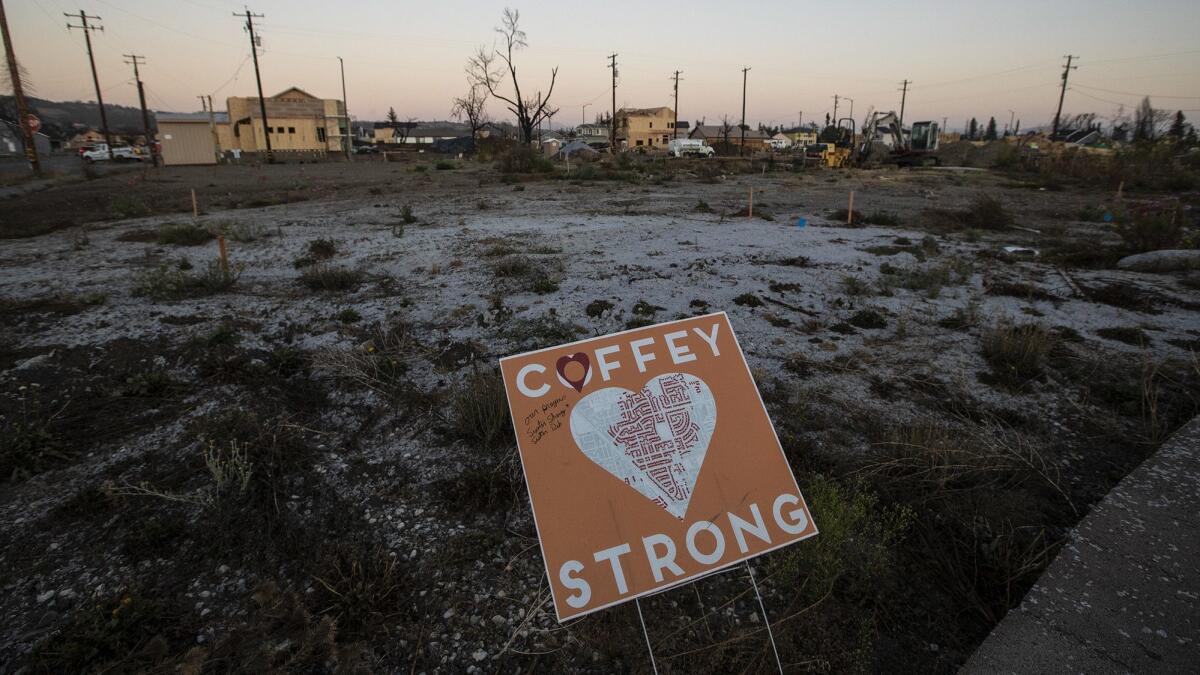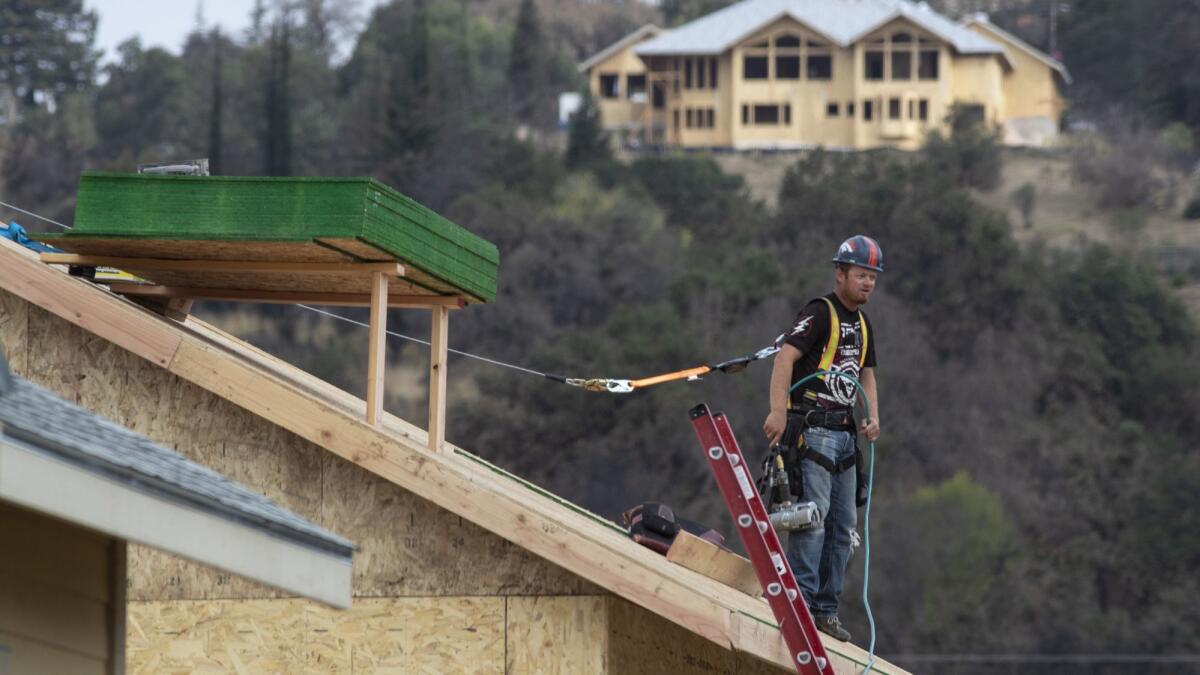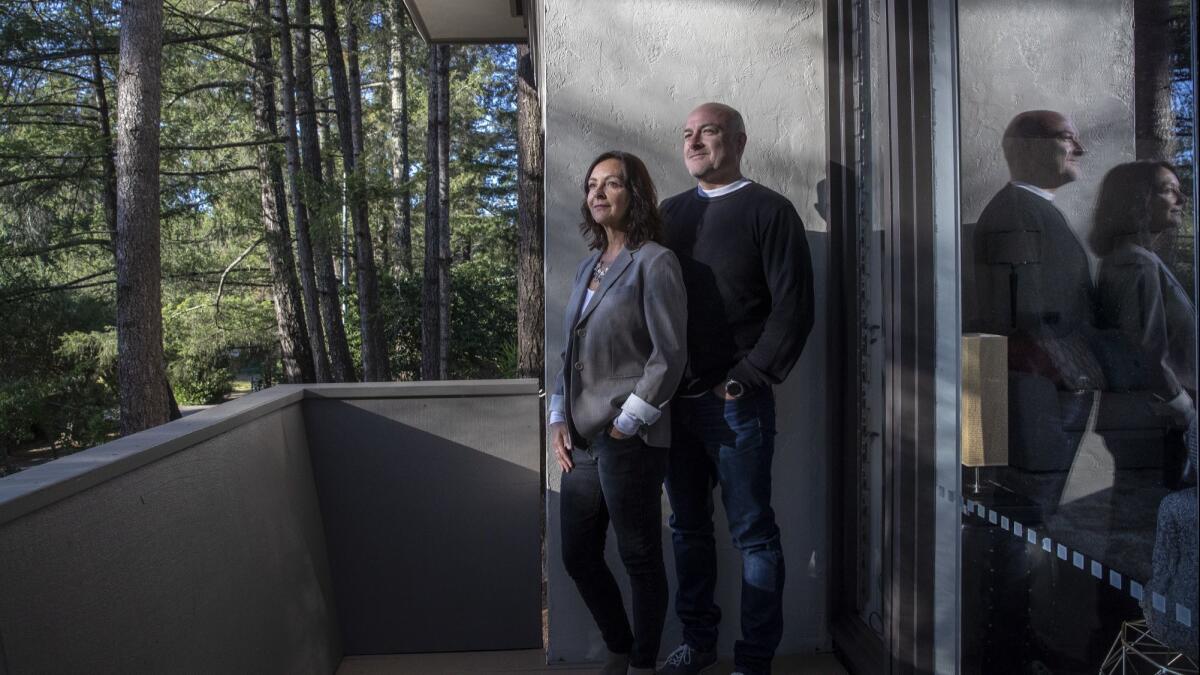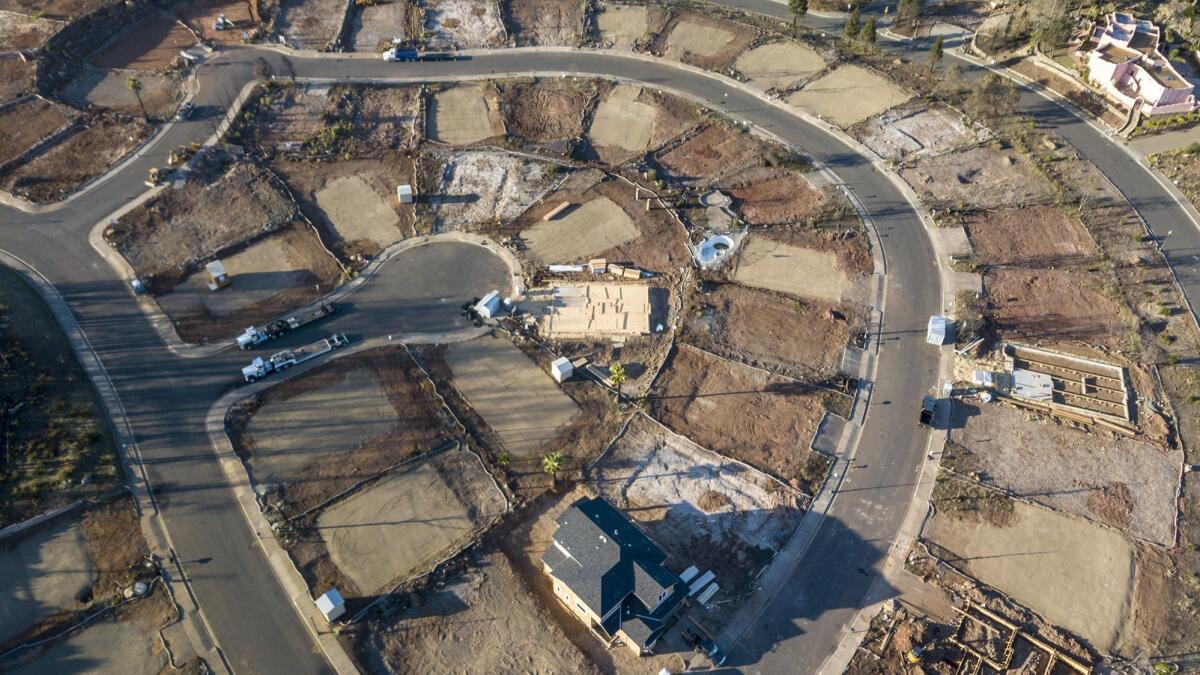One year after California’s most devastating wildfire, Santa Rosa is a patchwork of loss and renewal

- Share via
Reporting from Santa Rosa, Calif. — It was just one year ago when Tricia Woods lost her home in a single, impossible instant.
The Tubbs fire, the most destructive wildfire in California history, had ripped through Sonoma County and incinerated more than 5,500 homes, including the middle school teacher’s own four-bedroom house in the Coffey Park neighborhood of Santa Rosa.
That night, from an evacuation center at her daughter’s school, she called her insurance company and property manager. Right away, she knew she would rebuild.
“It was just such an achievement to be a woman on my own, to have bought a home in California on a teacher’s salary,” said Woods, a 47-year-old mother of three. “I wasn’t ready to let that go.”
But as Woods and thousands of others struggle to rebuild a year after the fire, they are encountering very different challenges based on class, location and fate.
Residents who face enormous insurance gaps are dipping into savings to construct houses similar to the ones they lost or building smaller ones. Others are buying elsewhere in a county that suffered a serious shortage of affordable housing even before the fires. In this increasingly ruthless housing market, displaced renters have been left to compete with more moneyed families who also lost their homes.
Some, reeling from the emotional trauma, left the area completely.
“For every person we find who’s doing great, there are a couple of people who aren’t,” Sonoma County Supervisor Shirlee Zane said.

This is especially true in hard-hit Santa Rosa, where the economics of reconstruction vary wildly from neighborhood to neighborhood.
More than 1,200 of the 2,700 homes lost in Santa Rosa are in the process of being rebuilt, according to numbers from the city. As of early October, 26 were complete.
Most of those finished homes are in Coffey Park, a predominantly middle-income neighborhood that is now a bustling construction zone. Woods herself said that despite a $150,000 insurance shortfall, the process of rebuilding there has been relatively simple.
The ease with which residents can rebuild depends on resources such as time and money, of course, but also location. In Coffey Park, the land is flat and the lots are smaller, making them easier to prepare for construction. Woods’ home is expected to be built by Christmas.
But just over Highway 101, in the affluent hillside enclave of Fountaingrove, things have been more difficult. City numbers show that 188 homes were being rebuilt in Fountaingrove as of Oct. 9. That figure was almost triple in Coffey Park.
In Fountaingrove, most of the homes sat on large lots with uneven topography, making them tricky to clear and more expensive to rebuild. On top of that, the neighborhood was plagued with water contamination issues after the fire, which melted plastic pipes and leaked benzene and other contaminants into the water supply.
Some of those Fountaingrove residents who are grappling with massive insurance shortfalls are still deciding whether it’s worth the stress and expense to rebuild. Others, like Ian and Lisa Alexander, have chosen to move on.
The Alexanders, both 54, had lived in their Fountaingrove home for 14 years when it burned to the ground. As Ian Alexander put it, the couple “lived like refugees” for months, moving from hotels to friends’ places to short-term rentals, while at the same time moving through their grief.
“We’d never wanted to build a house to begin with, and to think about doing it under these circumstances — it was never appealing,” said Lisa Alexander, who is a communications director for a nonprofit.
The couple decided to buy a mid-century modern home about two miles from their old place. It’s smaller than their Tudor-style in Fountaingrove, but it has a pool and is close to downtown.
“We’re sitting here on the anniversary of the fire, traveling the same streets we’ve always traveled, in a house that has a solid foundation for us to be happy and comfortable in,” said Ian Alexander, the co-founder of a software company. “We feel a tremendous amount of pain and loss, but also tremendous gratitude for being in a position to buy a new home.”

Also motivating the Alexanders’ decision was the fact that they were woefully underinsured. They would have paid around $700,000 out-of-pocket to build a comparably sized home on their property, which they still own.
The Alexanders are far from alone. In April, two-thirds of North Bay residents who lost their homes reported being underinsured by an average of $317,000, according to a survey by United Policyholders, a San Francisco-based nonprofit that helps people navigate their insurance policies.
The cause of this problem is manifold. Insurance companies use software programs to calculate the cost of rebuilding, but those estimates do not take into account the inflated cost of labor and materials that follow a disaster like this, said Keith Woods, CEO of North Coast Builders Exchange.
And if your home was built before the early 2000s, changes in building codes can increase the cost of construction by as much as 20%, according to Woods, who is not related to Tricia Woods of Coffey Park.
When Sonoma County Supervisor Susan Gorin has talked with contractors about rebuilding her own home in Santa Rosa, she’s been quoted $500 to $600 per square foot, whereas building a custom home before the fires would have cost around half that.
“It’s clear that insurance is really designed for losing a home in a house fire,” said Gorin, who is facing an insurance shortfall of more than $1 million. “It is not intended to cover replacement costs and code upgrades for 5,300 homes all at once.”
To complicate matters, contractors will not start a job unless they are sure there is enough money to complete a project, and time is of the essence. Most insurance policies will cover two years of rent, said United Policyholders Executive Director Amy Bach, leaving some residents a year to build homes before they’re forced to pay both a mortgage and rent.
Steve Morrow’s situation is unique in that he didn’t lose his home, but could still end up paying double. His trailer in Journey’s End, a mobile home park that sits below the hilly crests of Fountaingrove, was one of 44 that survived thanks to a heroic troop of neighbors and firefighters. The fire destroyed the park’s electrical and gas systems and contaminated the community’s well water, rendering the homes uninhabitable.
The owner of Journey’s End shut down the park, leaving Morrow, a 70-year-old Vietnam veteran, paying a mortgage on a mobile home he can’t live in. He’s renting a camper on an artist’s compound for more than $1,000 a month — an expense that is covered by insurance, at least for now.
Morrow said he’s “working like hell” to find an affordable lot where he can move his mobile home, but their cost has skyrocketed since the fire. Most recently, he was offered a small plot for $55,000, a large sum for a man who lives off Social Security and disability payments.
“Sooner or later I’ll find a place. I have no choice,” said Morrow, who has lived in Santa Rosa for 35 years. “It might just be a ways from here.”
The owner of Journey’s End is working with a nonprofit, Burbank Housing, to explore redeveloping the property into a mixture of affordable and market-rate apartments. By law, the park’s residents — most of whom were seniors with limited incomes — would be first in line for the affordable units, said Laurie Lynn Hogan, Burbank’s director of funding and communications.
But the proposed project is moving at an excruciatingly slow pace, Hogan said, partly because the nonprofit must work with state and federal agencies to relocate the surviving trailers.
“We are doing everything in our power to move things along as quickly as possible, with minimal success,” Hogan said.

Sonoma County, like much of the Bay Area, was already facing a dire shortage of affordable housing before the firestorm. The median home price there nearly doubled since 2009, according to Rick Laws, regional vice president of Pacific Union International, a real estate firm.
Recognizing that the fires would only exacerbate this crisis, the county scrambled to streamline its permitting and review process. Officials have also made it easier for residents to build larger accessory dwelling units, otherwise known as granny flats, on their properties while they rebuild their homes.
Even still, as many as 7,000 residents may have left Santa Rosa in 2017, according to an analysis by the Press Democrat, Santa Rosa’s daily newspaper.
“I’m not sure that those numbers really reflect what’s happening here,” said Santa Rosa Mayor Chris Coursey, a former Press Democrat reporter who believes that fewer people have left. Many residents are still living with family members, he said, and the city’s homeless population has grown 6% since last year.
It remains to be seen how the disaster will change the demographic makeup of the city. In Coffey Park, many of the homes are being rebuilt as investment properties that will be sold to the highest bidder, said resident Jeff Okrepkie. Before the fire, renters like him made up nearly half the community.
Most renters aren’t able to compete in such a red-hot housing market, said Okrepkie, founder of Coffey Strong, a nonprofit formed to aid the neighborhood’s recovery.
“This was was a very middle-class neighborhood of teachers, mechanics, hospitality industry workers,” Okrepkie said. “I’m worried that that’s going to change.”
For those left in Coffey Park, the neighborhood is irreparably changed. Most of the subdivision was erected in the ’80s, and its builders used fewer than ten floorplans for the tract homes. Now, more than 50 different builders are on-site, leading to a mosaic of modern architecture rising from the raw dirt.
Residents say that before the fire, Coffey Park was the kind of place where you’d wave to neighbors on the street, but you probably didn’t know them. Now, they describe the neighborhood as a big, unconventional family united by misfortune.
To witness this transformation, look no further than “Whine Wednesdays,” a weekly gathering in Coffey Park organized by Tricia Woods, the middle school teacher.
On the fire’s anniversary, a dozen or so displaced residents set up their camping chairs and folding tables in a quiet cul de sac. As they chatted over glasses of wine in the fading golden light, neighbors threw their arms around others and shared inside jokes as if they’d been friends for a lifetime.
In truth, it had only been for one very long, hard year.
[email protected] | Twitter: @LauraMNewberry
More to Read
Sign up for Essential California
The most important California stories and recommendations in your inbox every morning.
You may occasionally receive promotional content from the Los Angeles Times.











